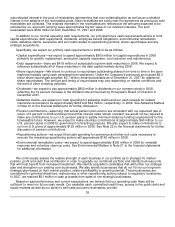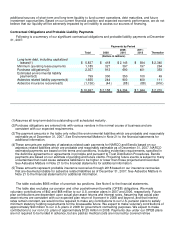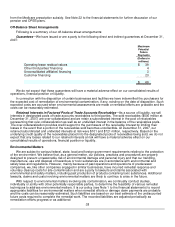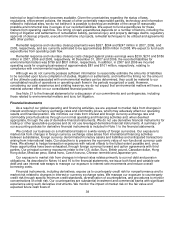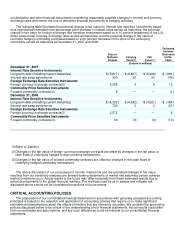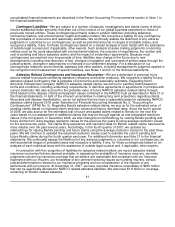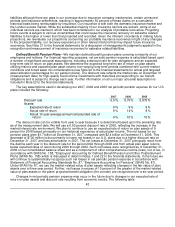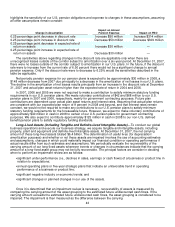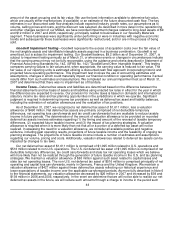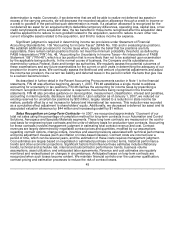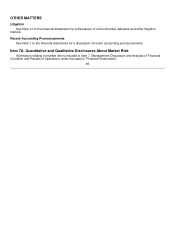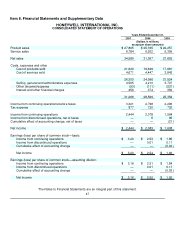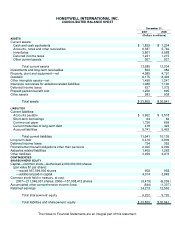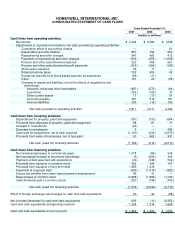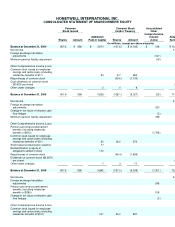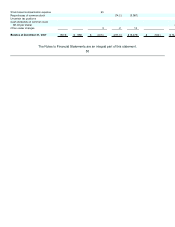Honeywell 2007 Annual Report Download - page 64
Download and view the complete annual report
Please find page 64 of the 2007 Honeywell annual report below. You can navigate through the pages in the report by either clicking on the pages listed below, or by using the keyword search tool below to find specific information within the annual report.
highlights the sensitivity of our U.S. pension obligations and expense to changes in these assumptions, assuming
all other assumptions remain constant:
Change in Assumption Impact on Annual
Pension Expense Impact on PBO
0.25 percentage point decrease in discount rate Increase $50 million Increase $314 million
0.25 percentage point increase in discount rate Decrease $50 million Decrease $309 million
0.25 percentage point decrease in expected rate of
return on assets Increase $30 million —
0.25 percentage point increase in expected rate of
return on assets Decrease $30 million —
The sensitivities above regarding changes in the discount rate are applicable only when there are
unrecognized losses outside of the corridor subject to amortization over a six-year period. At December 31, 2007,
there were no losses outside of the corridor subject to amortization in our U.S. plans. In the future, if the discount
rate were to increase from the current rate of 6.50 percent there would not be a significant change to annual
pension expense. Only if the discount rate were to decrease to 6.25% would the sensitivities described in the
table be applicable.
Net periodic pension expense for our pension plans is expected to be approximately $30 million in 2008, a
$148 million decrease from 2007 due principally to a decrease in the amortization of net losses in our U.S. plans.
The decline in the amortization of net losses results principally from an increase in the discount rate at December
31, 2007 and actual plan asset returns higher than the expected rate of return in 2004 and 2006.
In 2007, 2006 and 2005 we were not required to make a contribution to satisfy minimum statutory funding
requirements in our U.S. pension plans. We made voluntary contributions of $42 and $68 million to our U.S.
pension plans in 2007 and 2006, respectively, mainly for government contracting purposes. Future plan
contributions are dependent upon actual plan asset returns and interest rates. Assuming that actual plan returns
are consistent with our expected plan return of 9 percent in 2008 and beyond, and that interest rates remain
constant, we would not be required to make any contributions to our U.S. pension plans to satisfy minimum
statutory funding requirements for the foreseeable future. However, we expect to make voluntary contributions of
approximately $40 million in cash in 2008 to certain of our U.S. pension plans for government contracting
purposes. We also expect to contribute approximately $125 million in cash in 2008 to our non-U.S. defined
benefit pension plans to satisfy regulatory funding standards.
Long-Lived Assets (including Tangible and Definite-Lived Intangible Assets)—To conduct our global
business operations and execute our business strategy, we acquire tangible and intangible assets, including
property, plant and equipment and definite-lived intangible assets. At December 31, 2007, the net carrying
amount of these long-lived assets totaled $6.4 billion. The determination of useful lives (for depreciation/
amortization purposes) and whether or not these assets are impaired involves the use of accounting estimates
and assumptions, changes in which could materially impact our financial condition or operating performance if
actual results differ from such estimates and assumptions. We periodically evaluate the recoverability of the
carrying amount of our long-lived assets whenever events or changes in circumstances indicate that the carrying
amount of a long-lived asset group may not be fully recoverable. The principal factors we consider in deciding
when to perform an impairment review are as follows:
• significant under-performance (i.e., declines in sales, earnings or cash flows) of a business or product line in
relation to expectations;
•
annual operating plans or five-year strategic plans that indicate an unfavorable trend in operating
performance of a business or product line;
•
significant negative industry or economic trends; and
•
significant changes or planned changes in our use of the assets.
Once it is determined that an impairment review is necessary, recoverability of assets is measured by
comparing the carrying amount of the asset grouping to the estimated future undiscounted cash flows. If the
carrying amount exceeds the estimated future undiscounted cash flows, the asset grouping is considered to be
impaired. The impairment is then measured as the difference between the carrying
43


